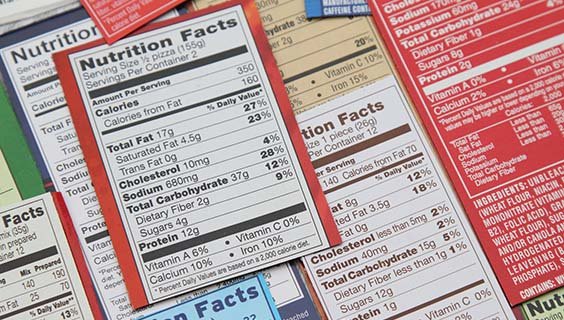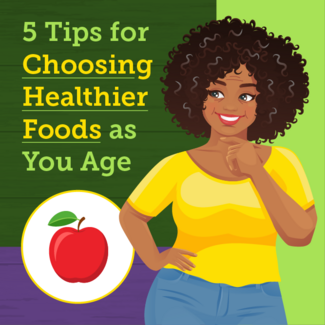How To Read Food and Beverage Labels
On this page:
 Understanding what’s in the foods and beverages we may consume can help us make healthier decisions. In many countries, including the United States, packaged foods and drinks — the types that come in cans, boxes, bottles, jars, and bags — include nutrition and ingredient information on their labels. However, sometimes these labels can be misleading and difficult to decipher. Read on to learn about the types of information that may be printed on food and beverage packaging and get tips for how to best interpret that information.
Understanding what’s in the foods and beverages we may consume can help us make healthier decisions. In many countries, including the United States, packaged foods and drinks — the types that come in cans, boxes, bottles, jars, and bags — include nutrition and ingredient information on their labels. However, sometimes these labels can be misleading and difficult to decipher. Read on to learn about the types of information that may be printed on food and beverage packaging and get tips for how to best interpret that information.
Understanding food and beverage product dates
There are three types of product dates commonly printed on packaged foods and beverages:
- “Sell by” tells how long the manufacturer suggests that a store should sell items such as meat, poultry, eggs, or milk products. Make sure you buy by this date.
- “Use by” tells how long items will be at peak quality. If you buy or use the product after that date, some might be stale or less tasty.
- “Best if used by” (or “best if used before”) tells how long the item will have the best flavor or quality.
None of these dates tell you when an item is no longer safe to eat or drink. In fact, product dates are not required by federal regulations and are added voluntarily by manufacturers.
Learn more about food safety and older adults.
How to read the Nutrition Facts label
The U.S. Food and Drug Administration (FDA) requires a Nutrition Facts label on most packaged foods and beverages. At the top of the Nutrition Facts label, you will find the total number of servings in the container and the food or beverage’s serving size. The serving size on the label is based on the amount of food that people may typically eat at one time and is not a recommendation of how much to eat. Read more about serving and portion sizes.

The remainder of the label information is usually based on one serving of the food or beverage (see Food Label A). However, if the container has more than one serving but typically might be consumed in one sitting — such as a pint of ice cream — the label will have two additional columns (see Food Label B). The first of these columns lists the calories and nutrients in one serving. The second lists that same information for the entire container. If you eat an entire package of food that contains two servings, you will get twice as many calories, nutrients, sugar, and fat as are in one serving.
Feeling confused about how much of these nutrients you should eat? Check out our resources about how much and what older adults should eat to support healthy aging.
Understanding percent Daily Value (% DV)
The percent Daily Value (% DV) tells how much a nutrient in a serving of the food or beverage contributes to a total daily 2,000-calorie diet. Although the average person needs 2,000 calories a day to maintain their weight, individuals may need more or fewer depending on their lifestyle. If you are eating fewer calories per day and eat one serving, your % DV will be higher than what you see on the label. Some nutrients on the Nutrition Facts label do not have a % DV, but consumers can still use the number of grams to compare and choose products.
Most older adults exceed the recommended limits for saturated fats, sodium, and added sugars. Compare and choose foods to get less than 100% DV of these each day, making sure to adjust for how many calories are in your diet. Additionally, many older adults do not get the recommended amounts of dietary fiber, vitamin D, calcium, and potassium. Eating enough foods that contain these nutrients can reduce the risk of developing some diseases and conditions, such as cardiovascular disease, osteoporosis, and high blood pressure. Compare and choose foods to aim for 100% DV of these nutrients.
The % DV information is not calculated with the unique needs of older adults in mind. Read the nutrition label as a whole to determine how a particular food or drink fits into your healthy eating pattern.
How to read the ingredient list
The ingredients in packaged food and beverage items are listed separately from (and often below) the Nutrition Facts label. This information lists each ingredient in the product by its common or usual name, and in descending order by weight. That is, the ingredient that weighs the most is listed first, and the ingredient that weighs the least is listed last.
Be on the lookout for terms that indicate added sugar, such as brown sugar, corn sweetener, corn syrup, dextrose, fructose, and high-fructose corn syrup. Artificial sweeteners such as sucralose, saccharin, aspartame, and acesulfame should also be consumed in moderation.
Light, low-calorie, organic labeling — what do these mean?
Sometimes, food and beverage packaging includes terms that may try to convince the consumer the food is healthy. To help avoid confusion, the FDA sets specific rules for what food manufacturers can call “light,” “low,” “reduced,” “free,” and other terms. This type of labeling may have little to do with how nutritious the food is. Here are some examples and what they mean:
- Light. Light products are processed to reduce either calories or fat. This may sound healthy, but some “light” products are simply watered down. Check carefully to see if anything has been added to make up for the reduced calories and fat, such as sugar.
- Low-fat, low-calorie, low-carb. These foods have a legal limit to how many calories, grams of fat, or carbohydrates (carbs) they can contain per serving. However, if a serving size is very small, you may end up eating multiple servings in one sitting, ultimately consuming the same amount of fat, calories, and carbs as the regular version of the food.
- Multigrain. This sounds healthy but only means that a product contains more than one type of grain. Unless the product is marked as whole grain, it is possible the grains are all refined grains, which have likely lost important nutrients during processing.
- Organic. Products declared organic must be produced without conventional pesticides, synthetic fertilizers, biotechnology, or ionizing radiation. Organic animals must be fed organic feed and not be injected with hormones or antibiotics. Remember, organic foods may still have the same number of calories, fats, proteins, and carbs as a nonorganic food.
While these descriptions or terms are regulated by the FDA, others aren’t, so always check the nutrition label to see if the product matches your healthy eating goals.
If you’re unsure about an ingredient or label description, visit the FDA website to learn more.
You may also be interested in
- Reading more about how to overcome roadblocks to healthy eating
- Exploring healthy eating while having Alzheimer's disease
- Learning ways to maintain a healthy weight
Sign up for e-alerts about healthy aging
For more information about food labels
USDA MyPlate
703-305-2060
www.myplate.gov
U.S. Department of Health and Human Services
877-696-6775
www.foodsafety.gov
www.hhs.gov
U.S. Food and Drug Administration
888-463-6332
druginfo@fda.hhs.gov
www.fda.gov
This content is provided by the NIH National Institute on Aging (NIA). NIA scientists and other experts review this content to ensure it is accurate and up to date.
Content reviewed:
February 24, 2022



